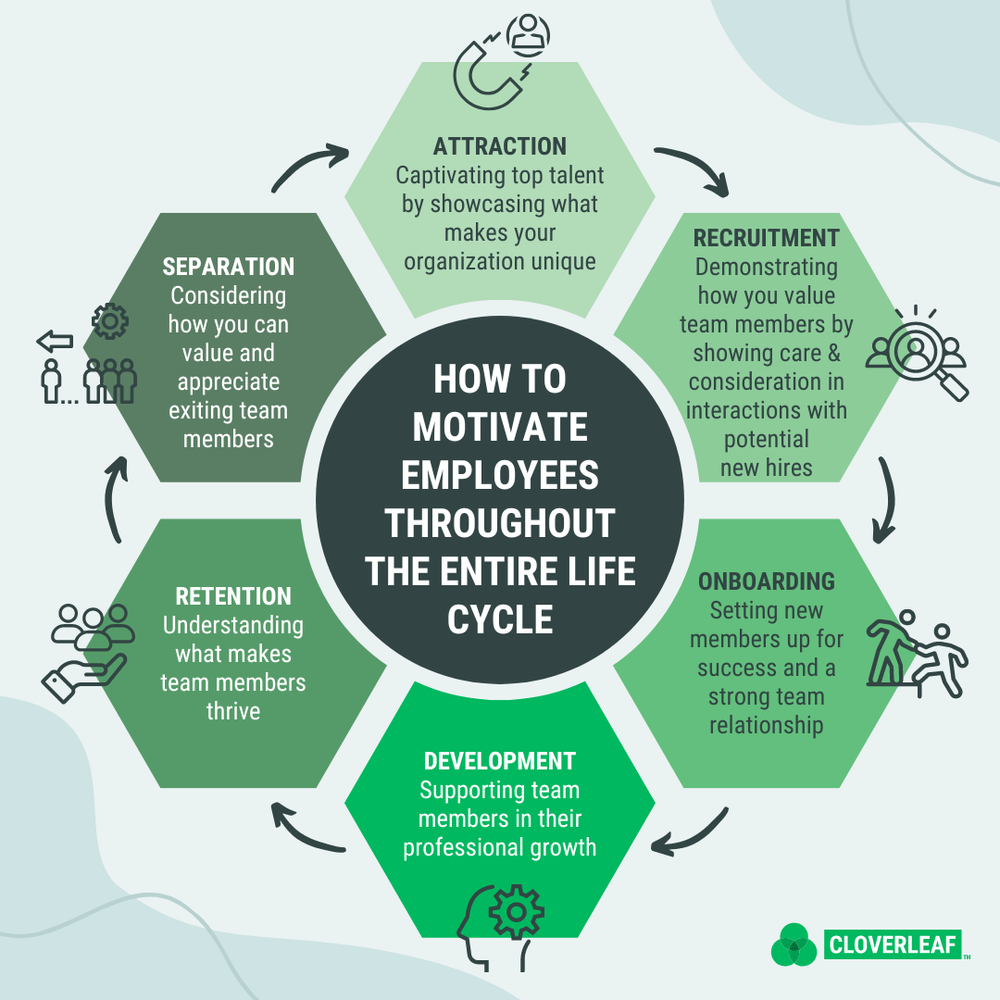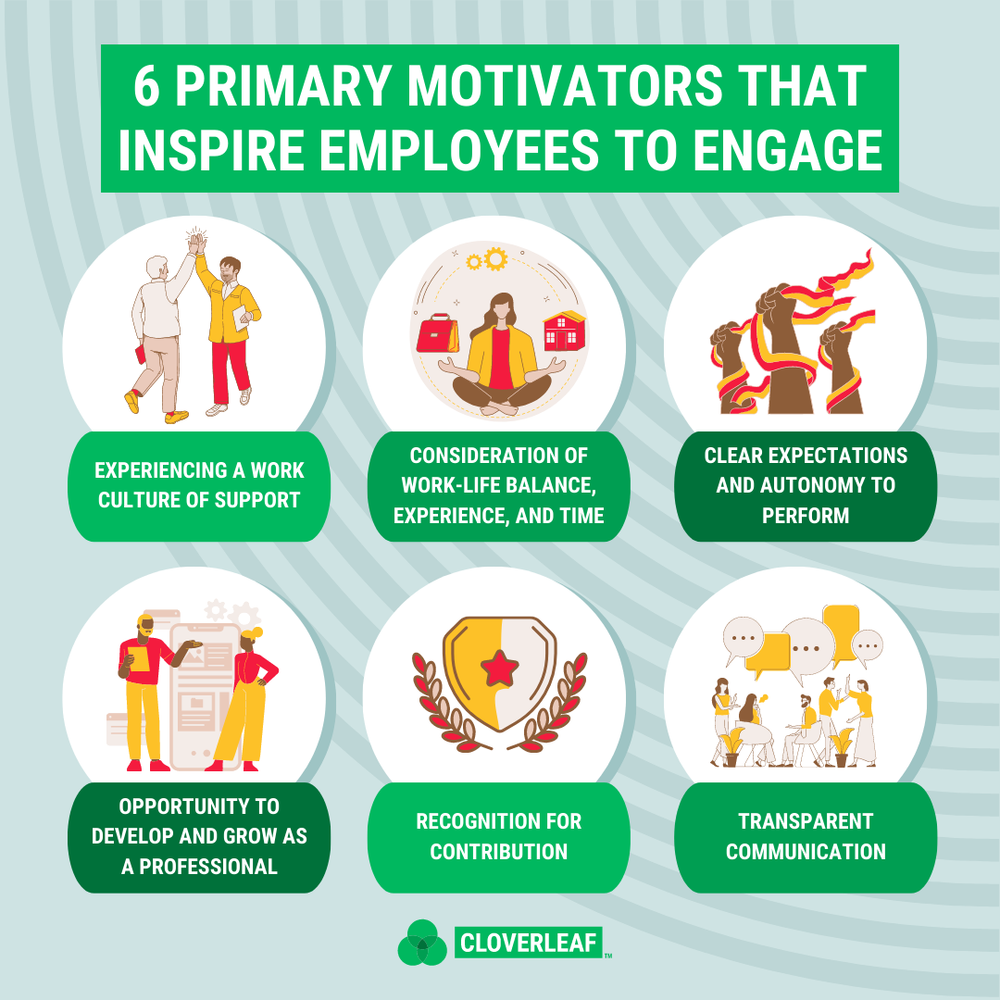Is motivation fully automated yet? While much of our lives and work processes are automated, motivating employees still requires human interaction. As leaders and learning professionals, we still must ask ourselves a few questions about how to motivate employees:
How are we motivating people in our organization?
What is new concerning how organizations are motivating employees?
Are we using old (and outdated) employee motivation tactics?
How are we supporting managers with tools and resources to support their effort to motivate their team?
Staying current on motivating employees is crucial as the workforce and the job market evolves. Technology can undoubtedly help gather data, provide feedback, and track performance, but it cannot replace the personal touch and human connection that is crucial in motivation.
Key Takeaways:
Motivation is a component of engagement
Engagement is an indicator of a team member’s level of motivation
Employee motivation requires meaningful work and a supportive environment
Organizations can motivate employees at every stage of a team member’s life cycle
A motivating workplace has a noticeable alignment between the organization’s values and actions
Ultimately, it is up to leaders and managers to stay informed, adapt to new methods, and use technology and interpersonal skills to create a motivational work environment that engages their employees.

Motivation, Engagement, Or Both? How Do These Elements Work Together?
While motivation is the driving force behind an individual’s actions, engagement extends beyond that. Engagement encompasses motivation and the employee’s level of involvement, commitment, and connection to the company and its objectives. Additionally, engagement gauges how fully employees are invested in and connected to their work and how motivated they are to give their all.
Therefore, while motivation may inspire an employee to show up and fulfill the minimum requirements, engagement ignites a deeper level of devotion, efficiency, and job fulfillment.
Leaders and managers must understand these two concepts to create a supportive and empowering work environment that motivates and fully engages their employees. Read the employee engagement strategy post for more on creating a human-centered workplace.
To further nuance these differences, consider that a team member may feel motivated to complete their tasks but not genuinely engaged in their work. This motivation is driven by the desire to finish and does not indicate their level of engagement.
On the other hand, an individual can be engaged in their work but lack direction or support from their manager, which can be demotivating. This scenario represents a missed opportunity by overlooking the potential of a ready and engaged team member that their leader failed to motivate effectively.

HUMAN SKILL PROGRAMS ARE HITTING LIMITATIONS...
- Close the widening gap between learning and on-the-job application
- Overcome the tension of pausing productivity for development opportunities
- Integrate learning so it is actually in the flow of work
- The evolution of human skill development
- What Automated Coaching™ is and how it works.
With that in mind, it’s worth exploring the employee life cycle and its impact on these six motivating factors. While a quick internet search may present numerous versions of the employee life cycle, two primary objectives must resonate within each stage:
How can we communicate that we have a culture of motivation and engagement?
How can we ensure we consistently deliver on that promise?
Considering these values requires a mindful approach to each stage of the employee’s journey with the organization. The focus should be on communicating and delivering a supportive and empowering work environment.
Now, let’s explore the different stages of the employee life cycle and how to effectively balance these two objectives to create a motivating work environment.

How To Motivate Employees Throughout The Entire Life Cycle
- Attraction
- Recruitment
- Onboarding
- Development
- Retention
- Separation
1. Attraction: Captivating top talent by showcasing what makes your organization unique.
This stage begins with the first glance at a job posting. What elements of your employer branding excite a potential candidate and make them say, “This is the place I want to work?”
Employers should review their entire attraction strategy with the following considerations:
How does our employer branding effectively communicate a culture of motivation and engagement?
How do our organizational features and benefits serve intrinsic and extrinsic motivation, and does our recruitment strategy align with this?
Why would a candidate choose our organization over a competitor?
How do we distinguish ourselves in our attraction messaging?
CHALLENGE: Consider what measures you take to energize team performance and assess if the content (or lack thereof) you share represents a culture that supports its team members.
2. Recruitment: Demonstrating how you value your team members by showing care and consideration in your interactions with potential new hires
Your recruitment process indicates the importance you place on motivating and engaging employees, and it can reveal a lot about your company’s culture.
Examine your entire hiring process, from initial communication to the offer, to determine how well it reflects your organization’s values. Consider aspects such as:
How efficient and effective is the communication between the hiring manager or recruiter and candidates throughout the hiring process?
How do the steps in the recruitment process value the time and experience of candidates?
What measures are in place to handle interruptions or delays in the process?
What alternative evaluation methods, such as work samples or presentations, are used in addition to interviews to assess candidates?
What steps are taken to provide constructive feedback to candidates who are not offered a job? (This is crucial and will set your organization apart if executed effectively.)
What communication strategies are in place during the transition between an offer being accepted and the first day of work to ensure new employees feel motivated and engaged from the start?
CHALLENGE: If you are a hybrid or all-virtual team and someone is coming on board who is remote, consider creating a personalized video introduction from team members as a welcoming gesture. This simple action can leave a remarkable impression, helping new hires feel valued and excited to join the team.3.
3. Onboarding: Setting New Members Up For Success And A Strong Team Relationship
Onboarding is a crucial step in the employee life cycle. Recent statistics are staggering and provide compelling reasoning for prioritizing this stage if employers want to motivate employees from the beginning.
According to Northpass, organizations that structure onboarding saw a 60% year-over-year improvement in revenue AND a 63% improvement in year-over-year customer satisfaction. But there is a gap. According to Gallup®, only 12% of employees agree that their company has a good onboarding process.
GenXers may remember the old marketing tagline for Head & Shoulders; you never get a second chance to make a first impression. The first impression employers make on a new hire is crucial and sets the foundation for their entire experience as an employee.
Leaders can motivate employees and spark engagement from the beginning with new team members by considering the following questions:
How can we formalize our onboarding process to better set new employees up for success and increase their motivation and engagement?
Do we articulate expectations for the new hire in their first 90 days, six months, and year?
To what extent do we equip managers with the skills and knowledge to effectively onboard new employees?
How do we ensure that onboarding is included in manager job descriptions and training programs?
How can we incorporate opportunities for new employees to connect with their team and learn about the organization’s culture and values far beyond completing a checklist of tasks?
Who is responsible for regularly reviewing and updating our onboarding process to ensure it remains impactful and relevant to the needs of new hires?
CHALLENGE: What is one tangible action you can take to improve your onboarding to inspire new employees to put their best foot forward? Who do you need to communicate with to make this happen? (Hint: take action and schedule it now).

4. Development: Supporting team members in their professional growth
Unleashing personal development in the workplace is the key to sparking your teams’ motivation and fueling engagement! By actively investing in their professional success, you show your belief in their growth and set them up for long-term success.
Leaders who genuinely explore questions such as “How can we make our employees feel appreciated and valued?” “How can we enhance their morale?” and “How can we assess and continually improve the impact of our efforts?” with a curious mindset are more likely to retain motivated and engaged employees successfully.
9 Vital Employee Development Questions for Building a High-Performance and Engaging Workplace
What training and development opportunities do we offer individuals at every level of employment?
What changes need to be made to our performance management process to engage and motivate employees to perform at their best effectively?
How do we ensure that our people managers receive adequate training and coaching to fulfill their leadership roles effectively?
What are the defined leadership standards in our organizational values and job descriptions for managers?
What communication channels and support mechanisms are available for employees to express their needs and receive coaching or guidance?
Do we provide coaching and support opportunities for all levels of employees, or is it limited only to the upper management?
How can we facilitate and support leaders in understanding the motivations and drivers of their team members?
How can we create a supportive environment that empowers employees to communicate their needs openly?
How often do we evaluate the content of a person’s work and role to ensure alignment?
CHALLENGE: Take a closer look at these questions and notice your gut reactions. What strikes a chord? What makes you proud vs. what makes you cringe? Start a conversation with a colleague about the questions that highlight your organization’s strengths and opportunities for growth.
5. Retention: Understanding what makes team members thrive
When aiming to retain employees, it’s crucial to empower them to maintain motivation and envision a future with the organization. This requires a thorough understanding of each individual’s needs and providing viable career pathing support and structures for recognition.
To assess how motivating employees find your retention efforts, critically examine the resources and structures you have in place. This includes considering questions such as:
What career development resources and opportunities are available for employees?
How easily can employees network across the organization to forward their career aspirations?
What systems are in place for formal recognition of employee achievements and contributions?
What strategies does the organization provide for leaders to effectively integrate informal recognition into their management of teams and individuals?
How is career development incorporated into the performance evaluation process to retain high-performing employees?
CHALLENGE: Which of these questions does your organization most need to work on and why? Start talking. Have a conversation today about a gap you notice with a colleague at your leadership level. This can be casual and off the cuff but make sure it leads to tangible action.
6. Separation: Considering how you can value and appreciate exiting team members
Saying goodbye is never easy, even when someone leaves on good terms. Departures from the organization can be a valuable opportunity to gain insight into employee motivation and drive improvement for the future.
When people leave an organization, it is a significant opportunity for leaders to dig deeper into understanding employee motivation and learn from past experiences.
To maximize the learning opportunity presented by employee departures, it’s essential to assess the impact of the exit process and gather actionable insights. The following questions can guide this effort:
Is there a structured exit interview process in place? If not, what steps need to be taken to establish one?
How do we leverage the information gathered from exit interviews to improve future role fulfillment and overall organizational advancement?
When employees leave on good terms, what did we implement effectively to engage them in their role? And how can we replicate and enhance these approaches in future roles?
In the case of employees who depart on less favorable terms, where did we excel in motivating them, and where did we fall short? And how did the leaders play a role in the employee’s motivation and engagement, if at all?
Challenge: Start or evaluate your current exit interview process. Schedule a dedicated meeting with relevant stakeholders to potentially revise your exit interview process.
Conclusion
Learning to motivate employees is a complex and challenging task but can produce rewarding outcomes. Even implementing just one of these ideas can drive positive change and boost motivation in your workplace.
It’s important to remember that the amount of information presented can be overwhelming, which is a normal reaction. The key is to take the time to digest, reflect, and choose the strategies that will work best for your unique situation. Your organization can inspire and guide your team to reach its full potential.








